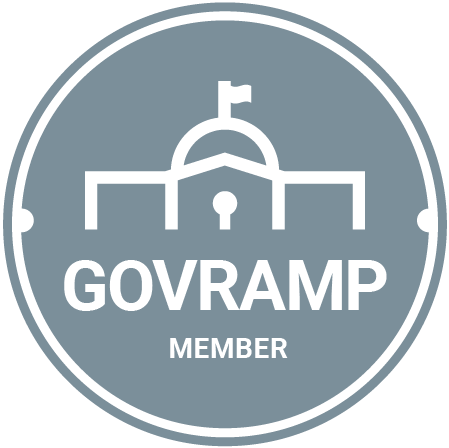With a budget of over $840 billion and 3.4 million service members and civilians, the Department of Defense (DoD) is America’s largest government agency. The Air Force – one of its military branches – provides “rapid, flexible, and lethal air and space capability that can deliver forces anywhere in the world within hours.” In order to meet its mission, the Air Force relies on highly-educated teams with expertise in science, technology, and more.
One of the teams supporting this effort is the Air Force Research Lab Materials and Manufacturing Directorate. Recently, Dr. Russ Kurtz, Director of Engineering and Dr. Cherish Lesko, Assistant Chief Engineer participated in a fireside chat with Authorium to discuss the steps they’re taking to address pain points in the Air Force’s procurement process and why they’re looking to AI to enhance their capabilities in this space.
Here are five key takeaways from the conversation:
1. Leverage the skills and knowledge of your unique team.
The Air Force Research Laboratory can be thought of as a “super lab,” with locations across the country, about 12,000 team members, and directorates that could each be thought of as their own lab. One of the directorates – Materials and Manufacturing – develops materials, processes, and advanced manufacturing technologies for aircraft, spacecraft, missiles, rockets, and ground-based systems and their structural, electronic and optical components.
They have a broad range of mission sets and when it comes to securing materials, services, and technologies to meet these needs – the procurement process becomes complicated.
Dr. Kurtz served as a 30 year military officer in the Air Force, and in his current role he calls upon his deep institutional knowledge to help identify solutions, scale them, and then deploy them in the field. Dr. Cherish Lesko is a newer addition to the Air Force, and brings with her a decade of experience doing small business materials research and development, and another 10 years as a college professor teaching material science and engineering. Together, Dr. Kurtz can draw on his knowledge of established protocols, and Dr. Lesko can bring a different perspective, from the private sector and academia, to find innovative solutions that leverage the expertise and experiences of everyone involved.
2. Let research guide your actions.
Back in 2021, Dr. Kurtz led a research effort into their Directorate’s internal processes. The research included a climate survey. When reviewing the results, it became clear that there was immense dissatisfaction with the contracting part of the procurement process. Team members were constantly behind their commercial counterparts, expressing that by the time they received approval for an advanced technology, and completed the award process, sometimes the technology was already out of date. Dr. Kurtz looked beyond his immediate team and observed that across the military branch, and throughout the broader DoD, there were others who expressed similar difficulties.
Using this data, the next step was to engage with leadership and devise a plan.
3. Gaining executive support is key.
Instead of proposing a short-term action, Dr. Kurtz advocated making improvements to the procurement process a more robust “campaign.” He presented his findings to his Unit’s leaders, worked to secure senior level buy-in, and collaborated with leadership – in this case, the “number three” person in the front office to bring people together and create blueprints for success. They worked through a series of exercises – sticky notes, whiteboarding, diagramming processes – and documenting what was important and what wasn’t to achieve success.
4. Identify your strengths and areas for opportunity.
Through these exercises, the team was able to identify their strengths. They documented their findings and shared them across their team. One key learning was recognizing that the knowledge and expertise that a Ph.D possesses is not the same as a successful program manager for contracts at a research lab.
Dr. Kurtz and Dr. Lesko shared an example of a senior level scientist who possesses great basic research, and is ready to broaden it. In order to bring in partners – either from another government entity or the commercial space – they need to go through contracts, Now that researcher is being asked to pivot from being an incredibly smart scientist or engineer who is passionate about their work to suddenly take on the responsibility of developing a statement of work (SOW), abide by extensive contracting regulations, and be familiar with the acronyms and processes to complete a successful award. This was clearly an area of opportunity for their unit.
5. Success doesn’t happen overnight.
While to outsiders it may appear that the Air Force’s work in leveraging technologies – including research into AI-driven solutions – may have happened overnight, there was a great deal of “stage setting” that went on behind the scenes. Dr. Kurtz and Dr. Lesko recognize the hard work that federal and state counterparts also put into their missions and emphasize the importance of having process, design, and objectives nailed down to use new tools and technologies successfully.
To hear more from Dr. Kurtz and Dr. Lesko and the Air Force’s work to deploy critical resources, watch the full conversation now.
More about Authorium’s work with the Air Force: In January 2024, Authorium was selected by AFWERX for a SBIR Phase 1, focusing on the development of complex RFP packages to address the most pressing challenges in the Air Force. The effort is a testament to Authorium’s commitment to revolutionize government procurement with Generative AI, aiming to significantly enhance the efficiency and effectiveness. Authorium’s platform continues to dramatically streamline document creation, reduce timelines from years to months, and frees up agency staff to focus on more high-value work.



